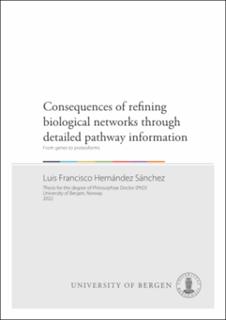| dc.contributor.author | Hernández Sánchez, Luis Francisco | |
| dc.date.accessioned | 2022-11-17T08:19:37Z | |
| dc.date.available | 2022-11-17T08:19:37Z | |
| dc.date.issued | 2022-11-28 | |
| dc.date.submitted | 2022-11-13T11:18:13.814Z | |
| dc.identifier | container/3f/d3/62/60/3fd36260-1a8e-484e-8a34-1bdabc2edb15 | |
| dc.identifier.isbn | 9788230866375 | |
| dc.identifier.isbn | 9788230844878 | |
| dc.identifier.uri | https://hdl.handle.net/11250/3032292 | |
| dc.description.abstract | Biologiske nettverk kan brukes til å modellere molekylære prosesser, forstå sykdomsprogresjon og finne nye behandlingsstrategier. Denne avhandlingen har undersøkt hvordan utformingen av slike nettverk påvirker deres struktur, og hvordan dette kan benyttes til å forbedre spesifisiteten for påfølgende analyser av slike modeller.
Det første som ble undersøkt var potensialet ved å bruke mer detaljerte molekylære data når man modellerer humane biokjemiske reaksjonsnettverk. Resultatene bekrefter at det er nok informasjon om proteoformer, det vil si proteiner i spesifikke post-translasjonelle tilstander, for systematiske analyser og viste også store forskjeller i strukturen mellom en gensentrisk og en proteoformsentrisk representasjon.
Deretter utviklet vi programmatisk tilgang og søk i slike nettverk basert på ulike typer av biomolekyler, samt en generisk algoritme som muliggjør fleksibel kartlegging av eksperimentelle data knyttet til den teoretiske representasjonen av proteoformer i referansedatabaser.
Til slutt ble det konstruert såkalte pathway-spesifikke nettverk ved bruk av ulike detaljnivåer ved representasjonen av biokjemiske reaksjoner. Her ble informasjon som vanligvis blir oversett i standard nettverksrepresentasjoner inkludert: små molekyler, isoformer og modifikasjoner. Strukturelle egenskaper, som nettverksstørrelse, graddistribusjon og tilkobling i både globale og lokale undernettverk, ble deretter analysert for å kvantifisere virkningene av endringene. | en_US |
| dc.description.abstract | Biological networks can be used to model molecular processes, understand disease progression, and find new treatment strategies. This thesis investigated how refining the design of biological networks influences their structure, and how this can be used to improve the specificity of pathway analyses.
First, we investigate the potential to use more detailed molecular data in current human biological pathways. We verified that there are enough proteoform annotations, i.e. information about proteins in specific post-translational states, for systematic analyses and characterized the structure of gene-centric versus proteoform-centric network representations of pathways.
Next, we enabled the programmatic search and mining of pathways using different models for biomolecules including proteoforms. We notably designed a generic proteoform matching algorithm enabling the flexible mapping of experimental data to the theoretic representation in reference databases.
Finally, we constructed pathway-based networks using different degrees of detail in the representation of biochemical reactions. We included information overlooked in most standard network representations: small molecules, isoforms, and post-translational modifications. Structural properties such as network size, degree distribution, and connectivity in both global and local subnetworks, were analysed to quantify the impact of the added molecular entities. | en_US |
| dc.language.iso | eng | en_US |
| dc.publisher | The University of Bergen | en_US |
| dc.relation.haspart | Paper I: Burger B, Hernández Sánchez LF, Lereim RR, Barsnes H, Vaudel M. Analyzing the Structure of Pathways and Its Influence on the Interpretation of Biomedical Proteomics Data Sets. J Proteome Res. 2018 Nov 2;17(11):3801-3809. The author accepted manuscript is available at: <a href="https://hdl.handle.net/1956/22539" target="blank">https://hdl.handle.net/1956/22539</a>. | en_US |
| dc.relation.haspart | Paper II: Hernández Sánchez LF, Burger B, Horro C, Fabregat A, Johansson S, Njølstad PR, Barsnes H, Hermjakob H, Vaudel M. PathwayMatcher: proteoform-centric network construction enables fine-granularity multiomics pathway mapping. Gigascience. 2019 Aug 1;8(8):giz088. The article is available at: <a href="https://hdl.handle.net/1956/22570" target="blank">https://hdl.handle.net/1956/22570</a>. | en_US |
| dc.relation.haspart | Paper III: Hernández Sánchez LF, Burger B, Castro Campos RA, Johansson S, Njølstad PR, Barsnes H, Vaudel M. Extending protein interaction networks using proteoforms and small molecules.Published preliminary results as preprint. The preprint is available in the thesis. The preprint is also available at: <a href="https://doi.org/10.1101/2022.09.06.506730" target="blank">https://doi.org/10.1101/2022.09.06.506730</a>. | en_US |
| dc.rights | In copyright | |
| dc.rights.uri | http://rightsstatements.org/page/InC/1.0/ | |
| dc.title | Consequences of refining biological networks through detailed pathway information : From genes to proteoforms | en_US |
| dc.type | Doctoral thesis | en_US |
| dc.date.updated | 2022-11-13T11:18:13.814Z | |
| dc.rights.holder | Copyright the Author. All rights reserved | en_US |
| dc.contributor.orcid | https://orcid.org/0000-0003-2809-1517 | |
| dc.description.degree | Doktorgradsavhandling | |
| fs.unitcode | 13-25-0 | |
